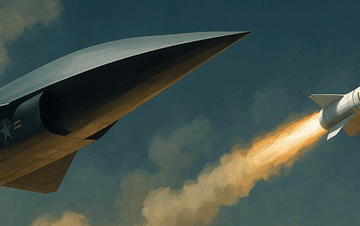The September 11, 2001, terrorist attack on the United States was a watershed moment that changed the focus of American national defense. In 2021, Brown University’s Watson Institute for International and Public Affairs released a report estimating international terrorism cost at $8 trillion in resources and over 900,000 lives. Decades of prioritizing terrorism, while neglecting strategic nuclear deterrence, left the US behind its adversaries in great-power competition.
Since 2021, Russia upgraded or modernized approximately 85 percent of its strategic nuclear arsenal. China undertook what then-Commander of United States Strategic Command, Admiral Charles Richard, called “a strategic breakout,” with “explosive growth in their nuclear and conventional forces.” North Korea went from a fledgling 1980’s nuclear program to possessing an intercontinental ballistic missile capable of reaching the continental United States. Iran’s nuclear program goes deeper underground, figuratively and literally, to avoid US threats and complicate US risk assessment.
Little occurred in the US nuclear arsenal during the same two decades. The nuclear enterprise is attempting to modernize each leg, with debatable levels of success. In June 2023, the Biden administration publicly confirmed and accepted American numerical nuclear inferiority for the first time since the end of the Cold War. The administration posits deterrence comes from quality over quantity. But how is a triad that is 30–50 years old qualitatively better than a new Russian arsenal?
The non-strategic nuclear arsenal rose in prominence as the Ukraine war began and Russia began making threats to attack the North Atlantic Treaty Organization’s member states. Production of the B61-13 and life extension of the W80-4 emphasize regional nuclear deterrence and may preempt strategic conflict at a lower level but may arrive too late. Retiring the B83 purportedly transfers the hard and deeply buried target (HDBT) responsibility to the B61-13, streamlining the Department of Energy’s sustainment and modernization expenses. The Department of Defense is still weighing a 2022 study, evaluating future HDBT targets to demonstrate viability of the non-strategic capability.
Since 2021, the nuclear enterprise began receiving long-overdue attention, but it will take years to yield results. The enterprise competes for American talent, amongst lucrative technological fields, that it needs for successful reconstruction and for addressing the needs of the triad. The Fiscal Year (FY) 2023 National Defense Authorization Act (NDAA) authorized $500 million more than requested for plutonium pit production reconstitution at Savannah River and Los Alamos National Laboratories.
The National Nuclear Security Administration’s (NNSA) goal is to produce at least 80 plutonium pits per year, between the two facilities, by 2030. Assuming 80 pits per year went into refurbishing 85 percent of deployed nuclear warheads, matching Russia’s accomplishment, that pace would require nearly 16.5 years and almost 20 years for a 100 percent refurbishment. In FY 2024, the NNSA is requesting 8.6 percent more money than enacted in FY 2023 for the Product Modernization Program to support strategic nuclear weapons modification and life extension.
The Trump administration’s National Security Strategy and National Defense Strategy, refocused on strategic-level concerns, reprioritizing strategic power over Russia and China higher than post-9/11 terrorism. The 2018 Nuclear Posture Review (NPR) called for nuclear modernization, as previous NPRs did, but was followed by the financial resources outlined in the 2019 National Defense Authorization Act required for execution.
There is a nexus between terrorism, nuclear weapons, and immigration. Iran sponsors Hezbollah, Houthi rebels, and Hamas’ terror campaign against Israel. If Iran develops a nuclear weapon and provides it to any of these groups, the US may be left searching for nuclear fingerprints in the aftermath of a detonation. The Federation for American Immigration Reform reported Customs and Border Patrol data showing 3.2 million aliens illegally crossed into the US between October 2022 and October 2023. Among those apprehended, 172 aliens were suspected terrorists. One hundred sixty-nine attempted an illegal entry at the southern border. The notion of an attack on the homeland by terrorists using a smuggled weapon of mass destruction is a credible threat.
Law Enforcement sources assert terrorists can employ nuclear weapons without sophisticated delivery systems on US soil. Former FBI Assistant Director Chris Swecker described the US as extremely vulnerable to a catastrophic terrorist attack. Swecker suggested that the mismanaged southern border is the key source of that vulnerability, concurring with a warning presented in December 2023 by the Department of Homeland Security. Preventing such dangerous exposure belongs at the forefront as policymakers seek to correct three years of negligent border protection. American strategic deterrence once overshadowed immigration, reducing temptation from adversaries abroad.
Nuclear-armed nations and proliferators alike must remember any nuclear attack against the United States from a terrorist organization will result in retaliation against the nation providing the weapon, as codified in the Bush Doctrine found in the 2002 National Security Strategy. While internal politics unnecessarily expose the US, those responsible can project strength by reiterating the consequences of exploiting that vulnerability and reemphasizing nuclear deterrence.
Terrorism and nuclear war are real. The US cannot afford to alternately overlook one in favor of the other. When adversaries see vulnerabilities, it invites aggression. Controlling who and what comes across US borders is essential to keeping Americans safe. Maintaining a modern, reliable, and lethal nuclear deterrent can foundationally dissuade terrorist attacks on US soil.
Dan Wasserman was both a missile operations and maintenance officer in the United States Air Force. He remains active in the field. The views expressed are his own.





Agree totally. Washington DC has long been infamous for only being able to think about, and act on, one crisis/opportunity at a time. Nowhere has this been more conspicuous than with GWOT warfighting eclipsing Triad modernization, and then Triad modernization facing a bitter funding battle against counterterror — and also with neo-liberal social handouts aplenty. While numerous pundits urge our country to get onto a Hybrid Cold War II wartime defense industrial base footing, we also really REALLY ought to move beyond the “one big war at a time, one big crisis at a time” mentality….. BTW, this IS the Second Hybrid Cold War, since the First Cold War was also very much a hybrid war, using what cultural, economic, political, and informational weaponry existed before the Social Media Age began.